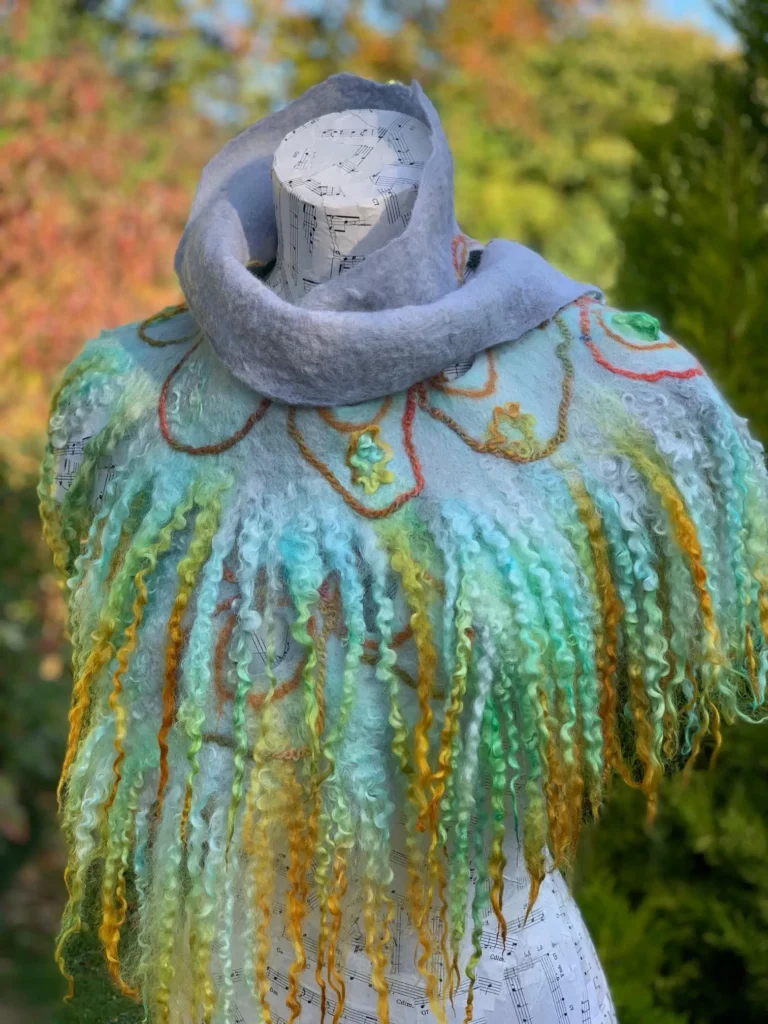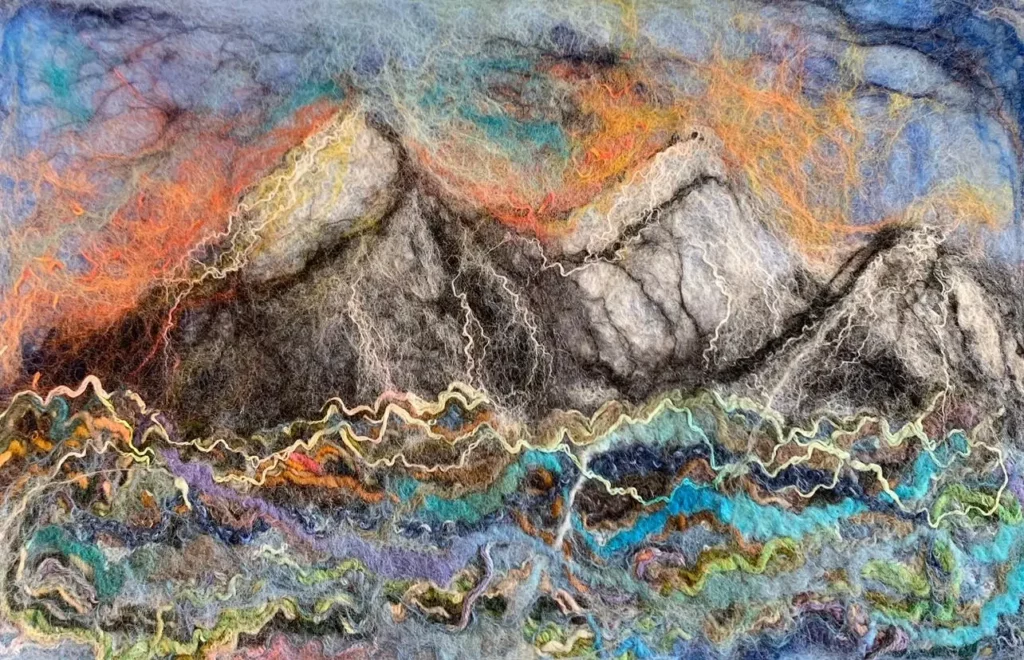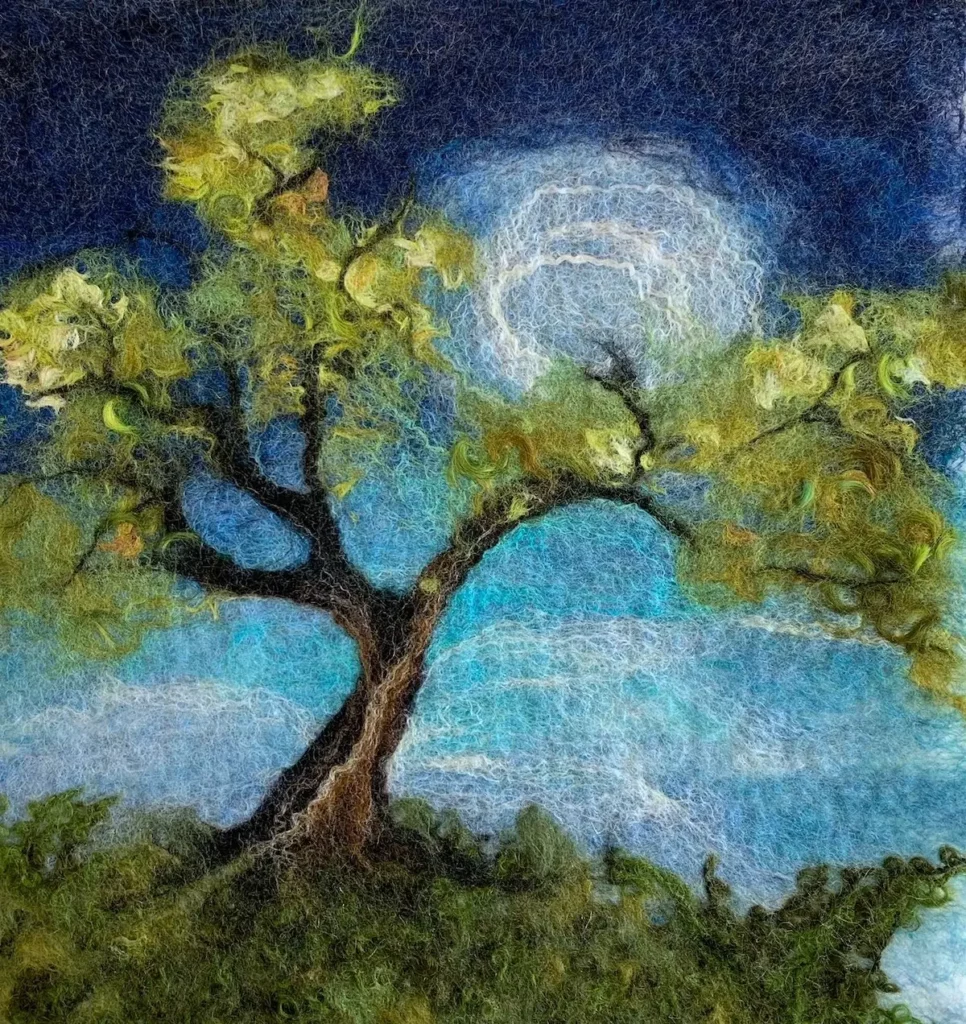Liz Riley is a feltmaker and textile artist who founded her small creative business in 2017. Her designs are inspired by experimenting with colour and texture, focusing on traditional feltmaking techniques her work combines art with a love for making wearable and useable items. Defined by strong colour combinations and colour blends using many hand dyed materials and hand spun yarns her work is characteristic of artisan felted work.

Accountant to full time felt Artist. Tell us more about your journey to be an artist. How did you find your creative niche?
I guess it all started early on as a child. I grew up in a creative environment as both my parents were always making something. They always encouraged us, me and my sisters, to learn a variety of different skills. In hindsight I think they taught us a great life lesson, somehow ‘making and creating’ can get you through the toughest times.
Over the years I have explored and learnt many crafts; knitting, crochet, lace making, tatting, sewing, embroidery you name it. In 2013 I visited a Wool Show and discovered felt! I loved the versatility and creative opportunities. If I’m honest, I also liked that I could start and finish a project quite quickly (I’m not a very speedy knitter you see). Working with wool fibre fascinated me, transforming a sheep’s fleece into fabric. I loved it and my journey began.
Having qualified as a chartered accountant and working in finance for over 20 years I made the decision In 2017 to leave my career behind and explore a creative lifestyle. Yes, a big move! I enjoyed my job but there are times when you just need to get off the ‘escalator’. My job ruled my life. Work life balance was more in favour of work! I left my employment and we eventually ended up moving to a village by the sea in North Yorkshire, England and haven’t looked back. I can’t say being a self employed textile artist doesn’t have it’s own challenges. I now fill every role, accountant, sales, marketing, purchasing. Days can be long but I have to say it’s so much more rewarding.
As an Amazon Associate I earn from qualifying purchases. Read more about our affiliate linking policy.

When you started felting, were you making just for fun or did you always envision it becoming a business?
I had no idea it would become a business, I just loved making felt. There came a point where I had so many felted items. I tried out a few craft events and was completely blown away by all the lovely comments about my work and people were buying it. To be honest I couldn’t quite believe it! It’s pretty much evolved from there. It’s still a journey and my work continues to develop and evolve.
When and how did you discover your talent? Does creativity come naturally or do you have to work on it?
I think starting early as a child helped, just learning how to focus and develop patience. Am I a natural, no I don’t think so. I’ve always had to work very hard at everything I’ve achieved. Sometimes it’s just been sheer determination that’s got me through. I don’t give up! I’ve read lot’s of books, tried many different techniques and had an abundance of failures! I’ve learnt a lot from these and developed techniques that now work for me. I work at my feltmaking everyday and I’m constantly thinking about new ideas and how to make them work.

Who or what are your main influences and inspirations?
What inspires and influences me? I would have to say it’s nature, the colours we see everyday are inspirational. Taking time to just walk and look at all the different colours around us and how they naturally work together gives me a basis for my work.
I read a lot and one of my all time favourite inspirational books is ‘500 Felt Objects, Creative Explorations of a Remarkable Material’ Lark Crafts Asheville. I picked this book up at a second hand bookstore and it illustrates the limitless potential of felt as an artistic medium. The great thing I found in this book is that it focuses on a material and demonstrates its potential and versatility.
Is your work more content-driven or process-driven? Does an idea inspire a work of art, or do the materials launch an idea?
I would have to say my work is content-driven. I always have an idea in my mind of what I’d like the finished piece to look like. I then start to consider my materials. I always start off by playing with colour combinations. To be honest, this is probably the part of my work that takes the longest, I’ll pick out various colours, some that will clearly work together. Then I’ll throw in a few odd balls to see what happens to the mix. I always take lots of photos of these combinations. You get a different aspect through a camera lens. I then walk away for a while and come back to them with fresh eyes.
Once I’m happy with my main colour choices I start to pick out materials that will add extra interest such as texture, I love to include lots of yarn in my work and will very often spin yarn that will compliment my design.

When you begin to create, do you visualise the finished piece? Or does the work evolve?
My work definitely evolves as I go along. I do have a fairly clear idea in my mind but as is often the case some things just don’t work. There have been occasions when the piece just doesn’t do what I envisaged. This can especially happen when I am working around a resist (or pattern) for the first time and the shape isn’t right or I haven’t quite got the size right to number of layers of wool. I have got a lot better at making sample pieces to test a pattern first but sometimes I just want to get all the ideas out of my head and into felt. Sometimes my work evolves into something completely different.
I enjoy this creative approach and some of my best pieces have emerged this way.
Do you focus on one piece exclusively from start to finish or work actively on more than one project at a time?
I am very much a thinker and I have to say I always give things in life careful consideration. I’m definitely not an impulsive decision maker. Very often I have a few projects on the go at the same time. I like to be able to re-visit a piece and think carefully about it. I find this forms my learning and developing process. I consider the aspects I like and those I don’t, how elements could be improved using different materials. Sometimes you get that happy accident too.

How often do you start a new project? Do you work actively on more than one project at a time?
I always plan each project. Very often this consists of drawing and logging ideas, designs and colours. I have lots of this planning for different projects going on at the same time. I have a terrible memory so I keep notebooks and sketch pads with not only ideas but the know how too. I will jot down how I made a piece, the type and amount of wool, sizing, number of layers used, method of laying fibres etc. I find keeping a diary an extremely useful tool for developing future ideas, I’m quite organised in this aspect (maybe this is the accountant in me).
When I have events or exhibitions to work towards I’m very focused and will be starting new projects regularly. I always like to keep a bigger project ongoing but I also like to work on smaller items daily so I feel that I’m achieving something and making progress.

Can you tell us about the inspiration and process of one of your works? How does a new work come about?
I love to walk. In North Yorkshire we have some beautiful countryside. One of my favourite places is on the North Yorkshire Moors. From July through to September the moors a vibrant with purple heather and in the winter they are quite desolate. This has been an inspiration for many pieces of work, both art work and art wear. I take lots of photographs whilst I’m out, the purple heather and contrasting green bracken together was a striking combination which just had to be re-created into scarves.
I initially created two pieces, a small scarf using Chiffon silk and Habotai silk and a larger piece on Ponge silk. I started by dyeing the silk fabric with a mixture of purple, lilac and olive colours in a tie-dye fashion, folding and twisting the fabric before the dyes were applied. I then matched the colours in the silk to wool fibres, I used Merino wool for it’s beautiful softness and blended with a mixture of Mulberry silk, Tussah silk and Bamboo fibres. I laid these blended wool fibres onto the silk quite thinly but also evenly to ensure a smooth fabric, I like felt to be well felted but also delicate, soft and elegant to give a nice drape to a garment.
Once my design is laid out, I take a photograph and step away for a while to reflect before the wet felting process begins. I use traditional felting methods, rubbing, rolling and kneading which I have adapted over the years to suit what works for me.

What part of felting do you enjoy most?
Wool is part of our history and heritage, it was first woven into cloth here in the Bronze Age, which began about 1900BC, however in historical terms this is comparatively recent, elsewhere in the world primitive man had domesticated the sheep in 10,000BC.
Making felt fascinates me. Taking fleece and applying traditional felt making techniques to create a fabric is an incredible process. The process is very simple. Using just soap, water and one’s own labour, is all that’s required for the task. I find it addictive, especially when I start experimenting with colour and texture. No one piece will ever come out the same so each one is totally unique too.

How do you know when a work is finished?
I always stick to ‘less is more’ when creating a piece of work. I’m always quite conscious about over embellishing. I try to stay with my original idea and take photographs as I go along to maintain perspective. There comes a time where I think I know instinctively when to stop.
What trends do you see in felting today?
We all hear news about climate change and we can see the impact, every business is shifting towards creating a sustainable future. Eco-friendly and sustainable materials are the new trends. I believe people are being more conscious about nature and its impacts on the environment. Felt products are the perfect choice for sustainability. the long term durable and eco-friendly characteristics of felt products make it a good choice. Felt is such a versatile material it can be used for all kinds of items, from things to wear or for the home.

If we were to visit your studio today, what would we find you working on?
At present I am working towards events that I have coming up. I am a member of a wool group, Embracing Wool (www.embracingwool.co.uk). The exhibition theme this year is ‘Walk into Nature’ so I’m busy creating work based around this theme. I’m also taking part in ArtFEST2023, a UK based art festival. There’s nothing like a bit of pressure to focus my mind.
What does being creative mean to you?
I believe that being creative is about being curious, enjoying learning new things and generating ideas, some of which will work and some won’t. The creative process involves recognising which ideas will work. Being creative isn’t just about art. There are so many different ways to be creative. Personally, I’m always searching for inspiration and looking to come up with new ideas and then try to express them in the means of art.

How much of your creative ability do you think is innate? Or is your creativity a skill that you have developed?
In my view creatives aren’t born, they’re created over time. I believe everybody is born with the gift of being able to be creative and you have to work at it. It’s learning and developing a skill. I was lucky having very creative parents who were always ‘making’. I think they set me on a creative path and passed on skills to learn how to be creative.

What is on your ‘someday’ creative wish list?
I would like to continue to developing my style. I get great pleasure and satisfaction from somebody looking at my work and saying ‘that’s a Liz Riley piece’.
Tell us about your blog and/or website. What do you hope people will gain by visiting?
During the pandemic I used the time to develop my website, blog and newsletters too.
My website is continually evolving, I want my website not only to be a Shop but a place to find interesting facts and information plus an avenue to promote the use of wool for sustainable living. Personally, being creative gives me a deep sense of wellbeing and I would like to share this,
I also teach workshops in the UK, so my website is also a place to encourage creativity in others.
Website: www.everythingfelt.co.uk
Social Media: www.instagram.com/everything_felt
Interview posted May 2023
Browse through more felting inspiration and stories on Create Whimsy.

